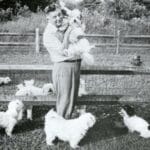Get ready to dive into the thrilling history of the Hungarian Vizsla, a breed as captivating as it is elegant. From their days roaming with the mighty Magyar tribes to their current status as loyal companions, we’ll uncover the secrets of this amazing hound. We’ll explore their breeding, their purpose, and the special place they hold in Hungarian culture. So sit back, relax, and let’s journey through time to discover the rich tapestry of the Hungarian Vizsla’s past.
History of Hungarian Vizsla
Ever heard of the Hungarian Vizsla? Picture this: a sleek, reddish-gold dog with an air of nobility and eyes that could melt your heart. That’s a Vizsla! These pups have a history as captivating as their looks, a story of resilience and deep bonds with humans spanning centuries.
Journey back to 8th-century Europe. The Magyar warriors, known for their strength and skill, relied on swift hunting companions. These weren’t just any dogs; these were the ancestors of our beloved Vizslas! As the centuries passed, these dogs became treasured by Hungarian nobility. They weren’t just tools for the hunt; they were companions, carefully bred for generations to be both skilled in the field and gentle at home.
But life isn’t always easy, even for a dog as special as the Vizsla. History threw some curveballs their way. The Turkish Occupation and later the Hungarian Civil War threatened their very existence. Imagine the dedication of those who believed in the breed, individuals like Elizabeth Mihalyi, who worked tirelessly to ensure the Vizsla’s story continued. They were guardians of a legacy.
Then came the World Wars, times of immense global upheaval. Sadly, the Vizsla population plummeted, teetering on the brink of extinction. But hope wasn’t lost. Remember Elizabeth Mihalyi? Her dedication, along with the efforts of the newly formed Vizsla Club of America, breathed life back into the breed.
Today, the Vizsla enjoys the best of both worlds. They’re still incredible hunting dogs, showcasing the instincts honed over generations. But they’re also cherished family members, bringing joy and companionship to homes far beyond the Hungarian plains.
The story of the Hungarian Vizsla isn’t just about a breed; it’s a testament to the powerful bond between humans and dogs. It reminds us that even in the face of hardship, dedication and passion can save something truly special. And who knows what the future holds? With ongoing research and a growing community of Vizsla enthusiasts, their story is still being written.
Key Points of the History of Hungarian Vizsla:
- 8th Century Origin: Ancestors of the Vizsla were hunting companions of Magyar warriors.
- Prized by Hungarian Nobility: They became cherished companions, bred for both hunting skills and gentle nature.
- Historical Challenges: Turkish Occupation and Hungarian Civil War threatened their existence.
- Dedicated Guardians: Elizabeth Mihalyi and others worked tirelessly to preserve the breed.
- World War Devastation: The Vizsla population nearly went extinct due to war.
- Post-War Revival: The Vizsla Club of America played a crucial role in the breed’s recovery.
- Modern Renaissance: Vizslas remain skilled hunting dogs while also enjoying family life.
- Bond between Humans and Dogs: The Vizsla’s history highlights the enduring relationship between humans and their canine companions.
- Ongoing Evolution: Research and a growing community continue to shape the story of the Hungarian Vizsla.
What was the Hungarian Vizsla originally bred for?
The Hungarian Vizsla’s story takes us back centuries to the ancient Magyar tribes who roamed the land we now know as Hungary. These tribes relied heavily on hunting, and they needed a dog that could keep up with their active lifestyle and be a valuable partner in the field.
Experts believe that the Vizsla’s ancestors were likely cherished by these tribes for their sharp senses and natural hunting instincts. They weren’t just pretty faces; these dogs had a knack for tracking game, pointing it out to the hunters, and then retrieving it once it had been caught. This combination of skills made the Vizsla an essential part of the Magyar way of life.
Key Lines:
- Ancient Hunting Origin: The Hungarian Vizsla emerged as a hunting companion in the 10th century, serving as a versatile pointer and retriever for Magyar tribes.
- Breed Resilience: Despite facing extinction twice, the Vizsla’s resilient spirit and enduring traits enabled its survival and preservation.
- Pointing and Retrieving Prowess: The Vizsla’s exceptional hunting abilities extend to both pointing out prey and retrieving it back to the hunter.
- Loyalty and Attachment: Beyond their hunting prowess, Vizslas are renowned for their unwavering loyalty, affectionate nature, and strong bonds with their human companions.
What Two Breeds Make a Vizsla?
The Vizsla’s origins can be traced back to ancient Hungary, where two remarkable breeds, the Transylvanian Hound and the Turkish Yellow Dog, played a pivotal role in its development.
The Transylvanian Hound, known for its exceptional hunting skills and unwavering determination, is still present today, serving as a living testament to the Vizsla’s heritage. The Turkish Yellow Dog, however, has vanished over time, leaving behind traces of its genetic legacy within the Vizslas we cherish.
These two distinct breeds, each possessing unique qualities, converged, giving rise to the Vizsla. They inherited the Transylvanian Hound’s exceptional hunting instincts and the enigmatic traits of the Turkish Yellow Dog, resulting in a dog that excels as both a skilled pointer and retriever.
Key Lines:
- The Vizsla, a cherished hunting companion, owes its existence to the interbreeding of two ancient Hungarian breeds: the Transylvanian Hound and the Turkish Yellow Dog.
- Despite the extinction of its Turkish Yellow Dog progenitor, the Transylvanian Hound continues to preserve the Vizsla’s distinctive traits and capabilities.
- The Vizsla’s multifaceted nature as both a pointer and a retriever reflects its rich Hungarian heritage as a versatile hunting breed.
- The Vizsla’s short, smooth coat, ranging from golden rust to copper-brown, reflects its elegant lineage and affinity for water.
Key Takeaways:
- The Vizsla’s family tree includes the Transylvanian Hound and the Turkish Yellow Dog.
- The Transylvanian Hound is still a big deal and helps us understand where the Vizsla’s hunting abilities come from.
- The Vizsla’s a pro at both pointing and retrieving, making them a super versatile hunting companion.
Why did Vizslas almost go extinct?
The Vizsla, despite its current popularity, has faced near-extinction twice in its history. In the 1800s, the breed’s popularity declined as new pointer breeds emerged, leading to a decrease in breeding efforts.
World Wars I and II dealt a devastating blow to the Vizsla population. The chaos and destruction of war severely disrupted breeding programs, and the breed’s numbers dwindled. After World War I, only a handful of pedigree Vizslas remained. However, dedicated breeders in Hungary and other countries refused to let the breed vanish. Through careful and selective breeding, they worked to preserve the Vizsla’s lineage and distinctive characteristics.
Key Lines:
- Near-extinction due to War and Hunting Decline: The Vizsla breed faced near-extinction in the 1800s due to declining popularity in hunting and the rise of other pointer breeds.
- Impact of World Wars: World Wars I and II severely depleted the Vizsla population, bringing it to the brink of extinction again.
- Post-War Recovery through Selective Breeding: Dedicated breeders played a crucial role in reviving the Vizsla breed after both world wars by preserving its lineage and selectively breeding to maintain its distinct characteristics.
- Unique History and Bloodlines: The Vizsla’s origin as a hunting dog in Hungary and its subsequent recovery from near-extinction shape its unique history and bloodlines, making it a prized breed today.
What was the original use of the Vizsla?
The Vizsla, whose lineage can be traced back over a millennium, was initially bred by Hungarian warriors to match the agility and strength of their cavalry. These dogs were primarily used as hunting companions in the vast Hungarian plains, where their exceptional pointing and retrieving skills proved invaluable.
Hungarian nobility recognized and cherished the Vizsla’s hunting prowess, taking great care to maintain the breed’s pure bloodline and distinctive golden-rust coat. This careful breeding over centuries ensured that the Vizsla’s natural hunting abilities were preserved and enhanced.
Key Lines:
- The Vizsla’s origins can be traced back to over a thousand years ago, where they were bred by Hungarian warriors to match their cavalry’s prowess.
- Predominantly utilized as hunting companions in the vast Hungarian plains, Vizslas were renowned for their exceptional pointing and retrieving abilities.
- Hungarian nobility highly valued and preserved the Vizsla’s pure bloodline, nurturing their hunting capabilities and distinctive golden-rust coloration.
- The Vizsla faced near extinction twice, first during the Turkish Occupation and again after World Wars and Russian Occupation, but was remarkably preserved through the efforts of dedicated enthusiasts.
What is the average lifespan of a Hungarian Vizsla?
The average lifespan of a Hungarian Vizsla typically ranges from 12 to 15 years. However, various factors can influence their longevity. Just like humans, a Vizsla’s lifespan is influenced by a combination of genetics, lifestyle, and environmental elements.
Factors such as diet, exercise, living environment, and overall health care play a significant role. Providing a Vizsla with a nutritious diet, ample exercise, and regular veterinary checkups can contribute to a longer and healthier life.
Key Lines:
- Vizslas typically have a lifespan ranging from 12 to 15 years.
- Proper nutrition, a supportive environment, and adequate exercise contribute to a longer life for Vizslas.
- Female Vizslas tend to live longer than their male counterparts.
- The Vizsla’s overall health and genetic background play a crucial role in determining its life expectancy.
What is the intelligence ranking of the Hungarian Vizsla?
In Stanley Coren’s renowned intelligence ranking of dog breeds, the Hungarian Vizsla secures an impressive #25 spot. This ranking places them in the upper echelon of canine intelligence, demonstrating their remarkable cognitive abilities.
Vizslas excel in obedience training and possess a remarkable working intelligence. They are quick learners, capable of mastering new commands with only 5 to 15 repetitions, and consistently obey known commands over 85% of the time.
Key Lines:
- Ranked #25 on Stanley Coren’s intelligence scale, the Hungarian Vizsla exhibits above-average cognitive abilities.
- Vizslas excel in obedience and working intelligence, mastering commands after 5-15 repetitions and obeying them over 85% of the time.
- Beyond obedience, Vizslas demonstrate strong instinctive intelligence in hunting tasks, particularly pointing and trailing.
- Adaptive intelligence allows Vizslas to navigate challenges and solve problems independently, enhancing their overall cognitive abilities.
What is the purpose of the Hungarian Vizsla?
The Hungarian Vizsla, often referred to as the “National Pointer of Hungary,” embodies versatility in the canine world. They are renowned for their exceptional skills in hunting, particularly pointing and retrieving game on both land and in water.
Beyond their hunting prowess, Vizslas are cherished for their affectionate and sensitive nature. They form strong bonds with their human companions, making them devoted family dogs.
Key Lines:
- The Hungarian Vizsla, also known as the “National Pointer of Hungary,” is renowned for its versatility in hunting, pointing, and retrieving game on land and in water.
- With an affectionate and sensitive nature, the Vizsla is not only an exceptional hunter but also a devoted companion and family dog.
- The breed’s lean and muscular build, coupled with its short, close-lying coat in shades of “golden rust,” makes it distinctive and well-suited for outdoor adventures.
- Despite its hunting heritage, the Vizsla has a gentle demeanor and a strong protective instinct, making it an ideal all-around companion.
What is the difference between American Vizsla and Hungarian Vizsla?
While both American and Hungarian Vizslas share a common ancestry rooted in Hungary’s rich hunting traditions, subtle distinctions have emerged over time, primarily in their physical attributes. American Vizslas tend to be slightly larger in stature than their Hungarian counterparts, often standing a bit taller and possessing a more muscular build.
The Hungarian Vizsla, on the other hand, is known for its short, dense coat, which requires minimal grooming and sheds less frequently compared to the American Vizsla’s coat. Despite their shared heritage, American Vizslas typically exhibit a distinctive “golden or rust” coloration, while Hungarian Vizslas retain a more classic solid golden hue.
Key Lines:
- American Vizslas are typically larger than Hungarian Vizslas, with a height difference of approximately 14 inches.
- While both breeds weigh around the same, American Vizslas have a more muscular build.
- The Hungarian Vizsla has a short, dense coat that is easy to groom and sheds less than the American Vizsla.
- Although originating from the same region, American Vizslas exhibit a distinct “golden or rust” coloration, while Hungarian Vizslas retain a more classic solid golden color.
When did Vizslas come to the US?
The Vizsla’s journey to America began in the aftermath of World War II, captivating the attention of American hunters who had heard tales of this exceptional Hungarian hunting dog. Intrigued by their reputation for remarkable skills in the field and their gentle, affectionate nature at home, Americans began importing Vizslas in the 1950s.
Key Lines:
- Key Line 1: Ancestry of Hungarian Vizslas
- The Vizsla, originating from Hungary, has roots traced to 8th-century hunting companions.
- Key Line 2: vizslas in the United States
- Following World War II, Vizslas were introduced to the US in the 1950s.
- Key Line 3: Importance in American History
- Vizslas played a significant role in rescue efforts after 9/11 and continue to serve in Seeing Eye programs.
- Key Line 4: Official Recognition in the US
- The American Kennel Club (AKC) officially recognized the Vizsla in 1960 as the 115th breed.
Is a Vizsla a good protection dog?
While Vizslas are known for their loyalty and may exhibit protective instincts toward their families, their temperament and breeding history suggest they are not ideally suited for a primary protection role.
Their lack of inherent territoriality and aggression, coupled with their friendly disposition, makes them less effective as guard dogs. Vizslas are more likely to greet strangers with enthusiasm than with suspicion. However, their alertness, keen senses, and distinctive bark make them excellent watchdogs.
Key Lines:
- Vizslas lack territoriality and aggression, making them unsuitable as guard dogs.
- Despite their protective nature, Vizslas’ friendly disposition limits their effectiveness in defending against intruders.
- Vizslas excel as watch dogs due to their alertness, keen senses, and loud bark.
- While Vizslas may exhibit protective behaviors, they typically refrain from aggressive confrontations.
For a comprehensive understanding of the development and origins of other fascinating breeds, explore our detailed accounts of the history of the Coton de Tulear and the captivating past of the Boerboel in our in-depth exploration of the history of the Boerboel.
- Unlock Elemental 2 Secrets: Actionable Insights Now - April 2, 2025
- Lot’s Wife’s Name: Unveiling the Mystery of Sodom’s Fall - April 2, 2025
- Photocell Sensors: A Complete Guide for Selection and Implementation - April 2, 2025
















